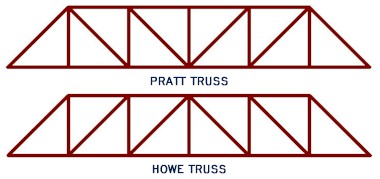 What's in a Truss?
What's in a Truss?
The Pratt truss was patented by Thomas and Caleb Pratt in 1844. It consists of multiple vertical members or "kingposts" with diagonal braces inclined up from the center forming V-shapes. It was a mirror image of the Howe truss, which had appeared in 1840 with diagonals sloping down from the center forming A-shapes.

The wire rigging that trussed the Chanute and Wright aircraft was sloped in both directions and formed X-shapes in the spaces or "bays" between the struts. It would seem to echo an earlier design, the Long truss developed by Stephen H. Long in 1830. It was used mostly in covered wooden bridges.

The truth is that an airplane is a very different animal from a bridge and none of these labels apply. A bridge supports its load in only one direction; airplane wings support loads from two. When the airplane is flying, the bracing wires sloping up from the center of the plane support the weight of the aircraft in the air. These are called "flying wires" (shown in blue). When the airplane is resting on the ground, the wires sloping down from the center support the weight of the wings. These are "landing wires" (red).
